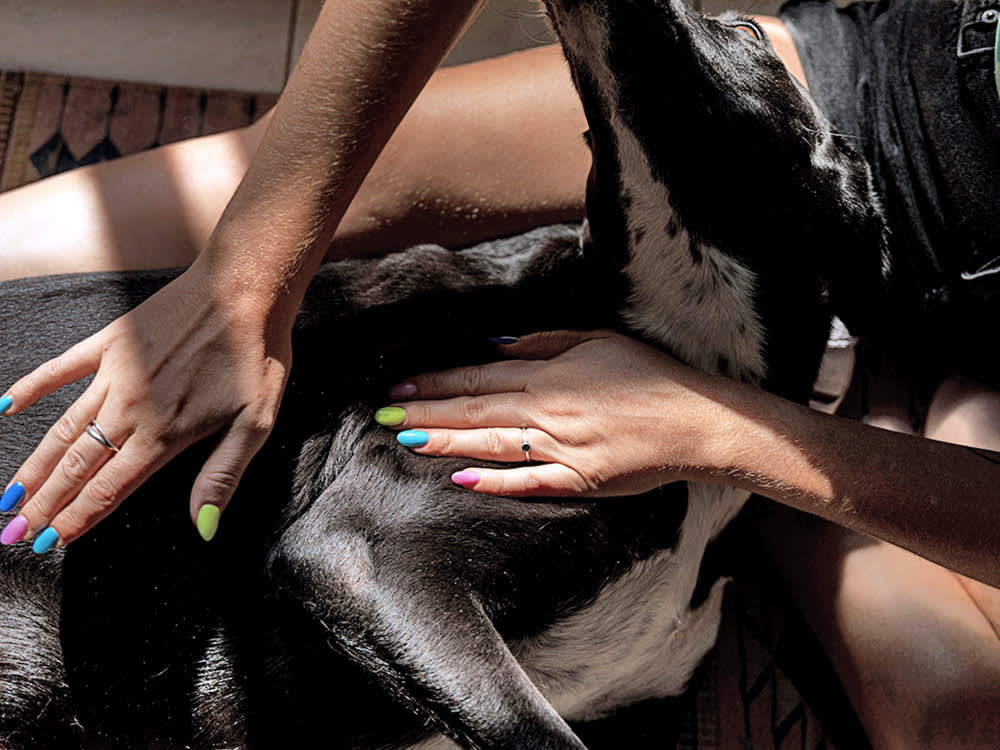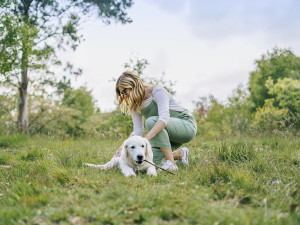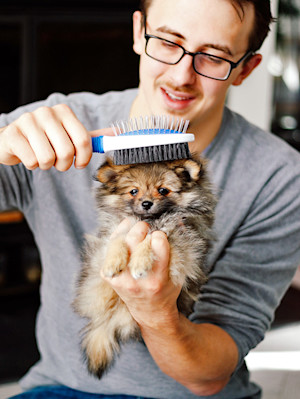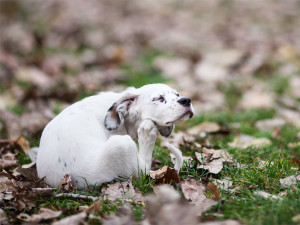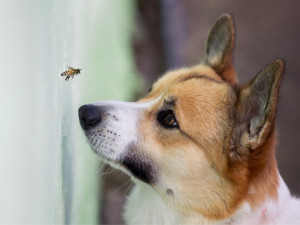What’s This Weird Lump Of Skin On My Dog?
Understand the causes, identification, treatment options and when to seek veterinary advice for skin tags on your dog
You’re curled up on the sofa with your dog, running your hand over their side as normal and wait, what’s this lump? Is it a scab? A tickopens in a new tab? Not sure? You may have found a skin tag. We all know what skin tags look like on ourselves and other humans, but what about our canine companions? In this article, we’ll look at whether skin tags on dogs are dangerous, find out which other dog skin growths look similar, and explore the different causes and treatment options for skin tags on dogs in the UK.
Skin tags are a common issue for a lot of pets and one that can be worrying for pet parents – finding a growth on your dog’s skin and not knowing what it is? Never fun! Most of the time though, it will turn out to be nothing. Read on to find out how to identify skin tags on dogs, what to do about it and we should do when we locate one of these little lumps.
littleKin™ is Kinship’s home just for puppy and kitten parents. Bop over to check out expert advice, new pet tools, and special deals—all curated for your newest family member.
opens in a new tabWhat are skin tags on dogs?
Skin tags, also called ‘fibrovascular papillomas’, are small, benign growths that can appear anywhere on the body. They usually appear as teardrop-shaped excess pieces of skin, sticking up or hanging down on a slight stalk from the body. They can be firm or soft and typically appear the same shade or slightly darker than the surrounding skin. Often, skin tags are only a few millimetres in size and are formed of whatever type of cellular structure they originate from. Because of this, in slightly more scaly areas, such as the elbow, the tag can also appear scaly. Skin tags on dogs can be found anywhere on the skin, even strange places like on the eyelids. But usually, they crop up over the neck, sternum (chest), face and legs.
While skin tags can sometimes appear scaly, this also goes for warts and other sorts of lumps and bumps that can occur on a dog’s skin. Let’s look first at the different types of skin growths that dogs can get to help figure out what you’re up against.
Skin tags: made from healthy skin cells, these growth appear small, pedunculated (on a stalk) and are a normal colour of skin.
Wart: caused by the dog papillomavirus creating small cauliflower-like growths. These are normal skin colour to grey.
Melanomaopens in a new tab: a benign or malignant tumour made from abnormal production of melanocytes (cells that produce melanin). These usually appear as black or dark lumps or masses.
Ticksopens in a new tab: a parasitic insect that bites and latches onto animals, including us!
Now, it may seem strange to have ticks on the same list here, but actually, skin tags and ticks can be confused very often. As a vet in Scotland, I see a great many ticks and sometimes they are the same colour as the surrounding skin. If the tick is attached to the dog it’s very difficult to see the tick’s head and legs, leaving dog parents naturally concerned about the new lump on their pet. Ticks are also a cause for concern so don’t rush to try to remove a new lump in case it’s a tick! Try to get a better visual to make sure it is a tick first; one way to do this is to take a photo and zoom in and you may see the little legs more clearly. Once identified, use tweezersopens in a new tab or a special tick-removal deviceopens in a new tab to remove the little pest.
Causes of skin tags in dogs
It is not fully known what causes skin tags to form. However, some factors do appear to increase the possibility of getting a new skin tag. These factors are genetics, age, areas of friction or trauma.
Breed: some breeds are more predisposed to skin tags than others. Typically these are the large and giant breeds, along with Spaniels, Boxers, Miniature Schnauzers, Poodles and English Bulldogs.
Age: most skin tags are noticed as dogs get older. Middle-aged and senior pupsopens in a new tab are more likely to have skin tags.
Friction: skin tags are often found in areas of friction, such as skin folds and near harnessesopens in a new tab.
Trauma: areas under pressure or trauma (such as elbows) can develop callouses and skin tags. Scratching continuously also produces a similar response.
If your pet has other skin issuesopens in a new tab that makes them itchyopens in a new tab, keep an eye out for skin tags. Scratching causes trauma to the skin so those dogs who are constantly scratching are more likely to end up with skin tags. Even more frustrating is that these skin tags may get scratched and bleed, causing further issues like infection.
Identifying skin tags on your dog
The best way to identify a skin tag is through visual inspection and physical palpation. The typical appearance of a skin tag is a small, teardrop-shaped piece of skin sticking out from the surrounding skin. It is usually a similar colour to the area or a shade darker and it can be firm or soft, and between the size of a sesame seed and a sunflower seed. The skin tag shouldn’t cause your furry friend any pain, if they react to you gently touching it, then it is best to get it checked out by a vet. Even if it is a skin tag and they are reacting to your touch in a negative way, it may be uncomfortable to them and need treatment.
The texture of a skin tag can vary from smooth and soft to more firm and scaly, but it should always stay the same. Any changes to it in size, texture or colour should be noted and checked out at your next vet appointment.
Other reasons to seek veterinary treatment for a skin tag would be if the skin looks irritated or sore. Redness, swelling and any discharge like pus is a sign of infection, in which case the skin tag may need treatment. Signs your furry friend may be uncomfortable with the tag are scratching, biting, nibbling. Even just gentle licking at it can be a self-soothing behaviour if it is sore. If you notice your pet doing these behaviours more often, make an appointment with your vet to get the lump seen.
Because skin tags are usually pretty small and we mainly notice them by stroking our pets, sometimes it can be really hard to find the lump again later. Either take a photo or make a note of its location before you head to the vet. I even had one genius client who circled it with a pet-safe marker prior to the appointment in order to help locate the lump. Top pet parent points for that one...
Are skin tags dangerous?
Usually, skin tags are benign and not dangerous to your pet. This doesn’t mean that they should be ignored. Skin tags can cause some issues or develop into other types of lumps so keeping an eye on them and noting if new ones appear is important. Skin tags can become harmful if they get in the way of your pet’s natural movement or catch on something. This can lead to bleeding, painopens in a new tab and increase the risk of infection. Skin tags stick out from the skin so it is easy for them to get caught on a harness, or when your pet is scratching.
If the skin tags are getting repeated trauma and are bleeding often then this is a sign that they need to be seen by the vets, as injury can lead to infection. If you see any swelling around the tag, bleeding or any oozing discharge, the tag should be looked at by a vet. Other reasons you may want your pet’s skin tag looked at are if it changes in shape, starts growing rapidly, or looks different in colour or texture than normal. These changes in appearance can sometimes be a sign the skin tag has developed into something else.
Treatment and removal options
Don’t try to remove a skin tag at home! This can cause pain, risk of infection and may complicate future removal. Instead, the best care for skin tags at home is monitoring each one and if there are signs of irritation, keep it clean, either with a pet-friendly, mild skin disinfectant or with plain, cooled, boiled water. Ensure harnesses or collars don’t sit over or rub skin tags, and provide soft bedding to help relieve the bony points like the elbows and hocks.
If your vet decides the skin tag needs to be removed, most vet practices have the facilities to remove them at your local general practice. There are different methods of removal depending on what is most appropriate for each case.
Cryotherapy: a non-invasive and quick procedure done under a local anaesthetic. The skin tag falls off a week or so after treatment. It may have to be done multiple times for full removal.
Cauterisation or electrocautery: non-invasive and quick, this procedure is done under local anaesthesia or general anaesthetic.
Surgical removal: a more invasive procedure performed under general anaesthesia. This is reserved for larger or more complicated cases requiring more precision.
The cost for skin tag removal in the UK varies from practice to practice. If your pet needs to go through a general anaesthetic the cost is usually higher, skin tag removal cost can start at around £100 and go through to over £500. Usually, skin tag removal can be performed at the same time as other surgeries or procedures. A common example is at the time of neutering or dental procedures. This lowers the overall cost to the client and the patient doesn’t need to go through an additional procedure and general anaesthetic.
Every UK vet practice will have had numerous patients experiencing new lumps or bumps and we inspect skin tags of all shapes and sizes often. This means that most general practice surgeries are equipped to give you and your furry friend a high level of experience and care when investigating skin tags and can provide treatment options if needed. There are practices that specialise in all things skin such as dermatology-specific hospitals or individual specialists within a practice. Search your local area for dermatology referral centres or ask your vet who they recommend locally.
In the UK, regulations state that only Veterinary Surgeons can operate and perform surgery into a body cavity, however minor surgery such as small lump removals can be performed by Registered Veterinary Nurses under the direction and supervision of a vet.
Preventing skin tags
But what about preventing skin tags in the first place? If we look at what may increase the risk of skin tags such as skin folds, rubbing of those folds, harnesses and collars and increased pressure on bony bits like the elbows, we start to see some things we can change.
Ensuring your pet is in a healthy body conditionopens in a new tab can minimise the number of excess folds rubbing against each other, and for the normal skin folds that some breeds have it is important to keep them clean to prevent irritation. There are pet-friendly wipes you can use to clean in the folds or you can use plain old water. Make sure to pat dry to prevent warm, moist areasopens in a new tab that harbour bacteria and fungal pathogens. Ensure harnesses and collars fit properly, anything too loose or too tight can create friction and irritation. It may be good to alternate two or more types of restraint methods that sit slightly differently on the body to prevent any chafing. Any excuse to buy yet another harness...
Providing soft, comfy bedding is important for those bony elbows and hocks, especially for our older pets who have earned the right for extended duvet days. This way the pressure can be reduced on those areas which are more at risk of getting skin tags and pressure sores.
Common myths and misconceptions
Skin tags are contagious
Don’t worry, skin tags aren’t contagious. They are not caused by any viral or bacterial sources, this myth may have come from the resemblance of skin tags to warts which can be from the papillomavirus in dogs. These are a different sort of skin lump altogether.
Skin tags will just regrow after removal
If they are removed the skin tag won’t grow back. However, if the tag was originally caused by friction in the area, more may start to grow nearby from the same cause.
You can remove skin tags at home
While this does sometimes occur with human patients, we cannot ask our furry friends if what we do is painful and so the risk is far too great to attempt any sort of removal at home without veterinary guidance. Removing skin tags at home also has a high risk of infection and complications may lead to more extensive treatment and need for surgical options.
Frequently asked questions
How do I know a skin tag needs treatment?
Any skin tag that shows signs of irritation, infection or is getting constantly caught or scratched needs probable treatment. Look for redness, swelling, discharge or bleeding along with signs your pets are uncomfortable with it such as nibbling or scratching it, they may even not allow you to inspect it if it’s sore.
Do I always need to see a vet if I find a skin tag?
No, if the skin tag remains small, normal size and texture and is not bothering your pet then it is OK just to monitor it at home. Try to keep a record or photo of them from time to time to help monitor for extended periods as it is hard to notice changes when inspecting them every day.
Does having skin tags mean my pet is unwell?
No, it is very common for skin tags to form especially as our pets get older. It does not mean your pet is unwell.
Conclusion
Skin tags are normal, typically benign lumps usually found in larger, older dogs. They can be found anywhere but often appear around the neck, face and legs. They don’t usually cause problems for your pet, but since they stand proud they sometimes can get caught or rubbed causing bleeding, pain and possibly infection. The cause of skin tags is not fully understood, however, they do crop up in areas under pressure and friction such as near skin folds or through trauma. Make sure harnesses and collars fit properly and don’t cause rubbing that either increases the risk of skin tags or irritates those already formed.
There are multiple options for skin tag removal in the UK which are performed at the vets. Skin tags should be monitored at home and regularly checked to look for changes in shape, size or colour as well as any signs of infection if they become irritated such as redness, swelling, discharge or excessive bleeding. If you notice any of these changes or are at all worried about a skin lump on your pet make an appointment with your vet in order for them to be checked out. When you take your dog to the vet, have a record ready of where the tag is located, how long it has been there and any symptoms or behaviour changes you have noticed.
It can be worrying to notice lumps and bumps on our furry friends, but rest assured skin tags are usually no cause for concern. In fact, they usually just means there’s more of them to love!
